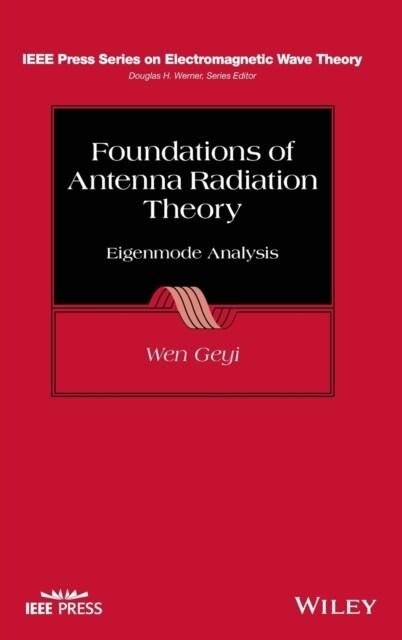책 이미지

책 정보
· 분류 : 외국도서 > 과학/수학/생태 > 과학 > 방사선/방사선학
· ISBN : 9781394170852
· 쪽수 : 448쪽
목차
Chapter 1 Eigenvalue Theory
1.1 Maxwell Equations
1.1.1 Wave Equations
1.1.2 Properties of Electromagnetic Fields
1.1.2.1 Superposition Theorem
1.1.2.2 Conservation of Electromagnetic Field Energy
1.1.2.3 Equivalence Theorems
1.1.2.4 Reciprocity
1.2 Methods for Partial Differential Equations
1.2.1 Method of Separation of Variables
1.2.1.1 Rectangular Coordinate System
1.2.1.2 Cylindrical Coordinate System
1.2.1.3 Spherical Coordinate System
1.2.2 Method of Green’s function
1.2.2.1 Green’s functions for Helmholtz Equation
1.2.2.2 Dyadic Green’s functions and Integral Representations
1.2.3 Variational Method
1.3 Eigenvalue Problem for Hermitian Matrix
1.3.1 Properties
1.3.2 Rayleigh Quotient
1.4 Eigenvalue Problems for the Laplace Operator on Scalar Field
1.4.1 Rayleigh Quotient
1.4.2 Properties of Eigenvalues
1.4.3 Completeness of Eigenfunctions
1.4.4 Differential Equations with Variable Coefficients
1.4.5 Green’s function and Spectral Representation
1.5 Eigenvalue Problems for the Laplace Operator on Vector Field
1.5.1 Rayleigh Quotient
1.5.2 Completeness of Vector Modal Functions
1.5.3 Classification of Vector Modal Functions
1.6 Ritz Method for the Solution of Eigenvalue Problem
1.7 Helmholtz Theorems
1.7.1 Helmholtz Theorem for the Field in Infinite Space
1.7.2 Helmholtz Theorem for the Field in Finite region
1.7.3 Helmholtz Theorem for Time-dependent Field
1.8 Curl Operator
1.8.1 Eigenfunctions of Curl Operator
1.8.2 Plane-Wave Expansions for Dyadic Green’s functions
Chapter 2 Radiation in Waveguide
2.1 Vector Modal Functions for Waveguide
2.1.1 Classification of Vector Modal Functions
2.1.2 Vector Modal Functions for Typical Waveguides
2.1.2.1 Rectangular Waveguide
2.1.2.2 Circular Waveguide
2.1.2.3 Coaxial Waveguide
2.2 Radiated Fields in Waveguide
2.2.1 Modal Expansions for the Fields and Dyadic Green’s Functions
2.2.2 Dyadic Green’s functions for Semi-infinite Waveguide
2.3 Waveguide Discontinuities
2.3.1 Excitation of Waveguide
2.3.2 Conducting Obstacles in Waveguide
2.3.3 Coupling by Small Aperture
2.4 Transient Fields in Waveguide
Chapter 3 Radiation in Cavity Resonator
3.1 Radiated Fields in Cavity Resonator
3.1.1 Classification of Vector Modal Functions for Cavity Resonator
3.1.2 Modal Expansions for the Fields and Dyadic Green’s functions
3.2 Cavity with Openings
3.3.1 Cavity with One Port
3.3.2 Cavity with Two Ports
3.4 Waveguide Cavity Resonator
3.4.1 Field Expansions by Vector Modal Functions of Waveguide
3.4.2 Modal Representations of Dyadic Green’s functions
3.5 Vector Modal Functions for Typical Waveguide Cavity Resonators
3.5.1 Rectangular Waveguide Cavity
3.5.2 Circular Waveguide Cavity
3.5.3 Coaxial Waveguide Cavity
3.6 Radiation in Waveguide Revisited
3.7 Transient Fields in Cavity Resonator
Chapter 4 Radiation in Free Space (I): Generic Properties
4.1 Antenna Parameters
4.1.1 Power, Efficiencies and Impedance
4.1.2 Field Regions, Radiation Pattern, Radiation Intensity, Directivity and Gain
4.1.3 Vector Effective Length, Equivalent Area and Antenna Factor
4.1.4 Antenna Quality Factor
4.2 Theory of Spherical Waveguide
4.2.1 Vector Modal Functions for Spherical Waveguide
4.2.2 Modal Expansions of Fields and Dyadic Green’s functions
4.2.3 Properties of Spherical Vector Wave Functions
4.2.4 Far-Zone fields
4.3 Stored Field Energies and Radiation Quality Factor
4.3.1 Stored Field Energies in General Materials
4.3.2 Stored Field Energies of Antenna
4.3.3 Radiated Field Energy
4.3.4 Evaluation of Radiation Quality Factor
4.4 Modal Quality Factors
4.4.1 Stored Field Energies Outside the Circumscribing Sphere of Antenna
4.4.2 Two Inequalities for Spherical Hankel Functions
4.4.3 Properties of Modal Quality Factors
4.4.4 Lower Bound for Antenna Quality Factor
4.5 Upper Bounds for the Products of Gain and Bandwidth
4.5.1 Directive Antenna
4.5.2 Omni-directional Antenna
4.5.3 Best Possible Antenna Performance-Guidelines for Small Antenna Design
4.6 Expansions of Radiated Fields in Time Domain
Chapter 5 Radiation in Free Space (II): Modal Analysis
5.1 Basic Antenna Types
5.2 Equivalent Current Distributions of Antenna
5.3 Antenna as a Waveguide Junction
5.4 Integral Equation Formulations
5.4.1 Compensation Theorem for Time-harmonic Fields
5.4.2 Integral Equations for Composite Structure
5.4.3 Integral Equation for Wire Antenna
5.5 Vertical Dipole
5.6 Horizontal Dipole
5.7 Loop
5.8 Spherical Dipole
5.9 Dipole near Conducting Sphere
5.10 Finite Length Wire Antenna
5.11 Aperture Antenna
5.12 Microstrip Patch Antenna
5.13 Resonant Mode Theory for Antenna Design
5.13.1 Formulations
5.13.2 Applications
Chapter 6 Radiation in Free Space (III): Array Analysis and Synthesis
6.1 Introduction to Array Analysis
6.1.1 Array Factor
6.1.2 Linear array
6.1.2.1 Linear Array with Uniform Amplitude
6.1.2.2 Linear Array with Non-uniform amplitude
6.1.3 Circular Array
6.1.4 Planar Array
6.2 Introduction to Array Synthesis with Conventional Methods
6.2.1 Array Factor and Space Factor for Line Source
6.2.2 Schelkunoff Unit Circle Method
6.2.3 Dolph-Chebyshev Method
6.2.4 Fourier Transform Method
6.2.4.1 Continuous Line Source
6.2.4.2 Linear Array
6.3 Power Transmission Between Two Antennas
6.3.1 The General Power Transmission Formula
6.3.2 Power Transmission between Two Planar Apertures
6.3.3 Power Transmission between Two Antennas with Large Separation
6.4 Synthesis of Antenna Arrays with MMPTE
6.4.1 Power Transmission between Two Antenna Arrays
6.4.1.1 Unconstrained Optimization
6.4.1.2 Weighted Optimization
6.4.1.3 Constrained Optimization
6.4.2 Applications
6.5 Synthesis of Arrays with EMMPTE
6.5.1 Array with Specified Energy Distribution
6.5.2 Arrays with Specified Power Distribution
6.5.3 Applications
Appendix A Vector Analysis
Appendix B Dyadic Analysis
Appendix C SI Unit System
Appendix D Unified Theory for Fields (UTF)
D.1 Lorentz Transformation
D.2 Maxwell-Like Equations Derived from an Ontological Vector Field
D.3 Field Equations Derived from an Ontological Scalar Field
D.3.1 Wave Equation Derived from an Ontological Scalar Field
D.3.2 Maxwell-Like Equations Derived from an Ontological Scalar Field
D.3.3 Conservation Laws
D.3.3.1 Conservation of Energy
D.3.3.2 Conservation of Momentum
D.4 Interaction between Two Systems
D.5 Applications
D5.1 Maxwell Equations Derived from a Static Electric Field
D5.2 Maxwell-Like Equations Derived from a Static Gravitational Field
D.6 Maxwell-Like Equations Derived from Einstein Field Equations
D.7 Universal Laws of Nature Derived from UTR





















